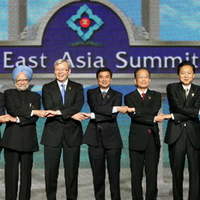As U.S. President Barack Obama prepares for his visit to Asia in June -- one of three potential roundtrips to the region this year -- it is worth exploring what Washington's future policy options are with respect to Asian regionalism.
The alphabet soup of the so-called "regional architecture" includes the Association of Southeast Asian Nations (ASEAN), the ASEAN Plus Three (APT), and APEC (Asia Pacific Economic Cooperation), to name just a few groupings. The main question now facing the United States is whether to join the East Asia Summit, a five-year-old body that groups the 10 countries of Southeast Asia as well as China, Japan, South Korea, India, Australia and New Zealand.
The impetus for joining is clear. Legally speaking, the United States meets all the criteria necessary for membership, having finally acceded to the Treaty of Amity and Cooperation (TAC) last year. Substantively, participating in Asian summitry demonstrates Washington's commitment to multilateralism, a symbolic yet significant metric in a region where process is equally important -- and sometimes more so -- than outcomes. "Half of diplomacy," as U.S. Secretary of State Hillary Clinton said in her speech on regional architecture earlier this year, "is showing up."

